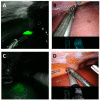The Role of ICG in Robot-Assisted Liver Resections
- PMID: 35743595
- PMCID: PMC9225074
- DOI: 10.3390/jcm11123527
The Role of ICG in Robot-Assisted Liver Resections
Abstract
Introduction: Robotic-assisted liver surgery (RALS) with its known limitations is gaining more importance. The fluorescent dye, indocyanine green (ICG), is a way to overcome some of these limitations. It accumulates in or around hepatic masses. The integrated near-infrared cameras help to visualize this accumulation. We aimed to compare the influence of ICG staining on the surgical and oncological outcomes in patients undergoing RALS. Material and Methods: Patients who underwent RALS between 2014 and 2021 at the Department of General Surgery at the University Hospital Schleswig-Holstein, Campus Kiel, were included. In 2019, ICG-supported RALS was introduced. Results: Fifty-four patients were included, with twenty-eight patients (50.9%) receiving preoperative ICG. Hepatocellular carcinoma (32.1%) was the main entity resected, followed by the metastasis of colorectal cancers (17%) and focal nodular hyperplasia (15.1%). ICG staining worked for different tumor entities, but diffuse staining was noted in patients with liver cirrhosis. However, ICG-supported RALS lasted shorter (142.7 ± 61.8 min vs. 246.4 ± 98.6 min, p < 0.001), tumors resected in the ICG cohort were significantly smaller (27.1 ± 25.0 mm vs. 47.6 ± 35.2 mm, p = 0.021) and more R0 resections were achieved by ICG-supported RALS (96.3% vs. 80.8%, p = 0.075). Conclusions: ICG-supported RALS achieve surgically and oncologically safe results, while overcoming the limitations of RALS.
Keywords: ICG; hepatic surgery; indocyanine green; liver surgery; minimally invasive hepatic surgery; robot-assisted hepatic surgery; robotic hepatic surgery; robotic liver surgery; robotic surgery.
Conflict of interest statement
J.H.B. is active as speaker for Johnson & Johnson Medical. J.H.B., T.B. and J.H.E. received grants for training with the da Vinci Xi Surgical System through Intuitive Surgical Sàrl. J.H.B. and J.H.E. work as proctors for Intuitive Surgical Sàrl. The sponsors had no role in the design, execution, interpretation or writing of the study. The other authors declare no conflict of interest.
Figures



Similar articles
-
Usability of Indocyanine Green in Robot-Assisted Hepatic Surgery.J Clin Med. 2021 Jan 25;10(3):456. doi: 10.3390/jcm10030456. J Clin Med. 2021. PMID: 33503996 Free PMC article.
-
Detection and Real-Time Surgical Assessment of Colorectal Liver Metastases Using Near-Infrared Fluorescence Imaging during Laparoscopic and Robotic-Assisted Resections.Cancers (Basel). 2024 Apr 24;16(9):1641. doi: 10.3390/cancers16091641. Cancers (Basel). 2024. PMID: 38730593 Free PMC article.
-
Tumor visualization and fluorescence angiography with indocyanine green (ICG) in laparoscopic and robotic hepatobiliary surgery - valuation of early adopters from Germany.Innov Surg Sci. 2021 Apr 22;6(2):59-66. doi: 10.1515/iss-2020-0019. eCollection 2021 Jun. Innov Surg Sci. 2021. PMID: 34589573 Free PMC article.
-
Near-Infrared Indocyanine Green-Enhanced Fluorescence and Minimally Invasive Colorectal Surgery: Review of the Literature.Surg Technol Int. 2018 Nov 11;33:77-83. Surg Technol Int. 2018. PMID: 30029290 Review.
-
The age of robotic surgery - Is laparoscopy dead?Arab J Urol. 2018 Jul 30;16(3):262-269. doi: 10.1016/j.aju.2018.07.003. eCollection 2018 Sep. Arab J Urol. 2018. PMID: 30140462 Free PMC article. Review.
Cited by
-
Surgical protocol of robotic liver resection using a two-surgeon technique (TAKUMI-3): a technical note and initial outcomes.World J Surg Oncol. 2025 Apr 7;23(1):124. doi: 10.1186/s12957-025-03785-3. World J Surg Oncol. 2025. PMID: 40197387 Free PMC article.
-
Indocyanine green dye and its application in gastrointestinal surgery: The future is bright green.World J Gastrointest Surg. 2023 Sep 27;15(9):1841-1857. doi: 10.4240/wjgs.v15.i9.1841. World J Gastrointest Surg. 2023. PMID: 37901741 Free PMC article. Review.
-
Use of Near-Infrared Fluorescence Techniques in Minimally Invasive Surgery for Colorectal Liver Metastases.J Clin Med. 2023 Aug 25;12(17):5536. doi: 10.3390/jcm12175536. J Clin Med. 2023. PMID: 37685603 Free PMC article. Review.
-
Robotic Versus Laparoscopic Liver Resection: A Nationwide Propensity Score Matched Analysis.Ann Surg Open. 2024 Nov 26;5(4):e527. doi: 10.1097/AS9.0000000000000527. eCollection 2024 Dec. Ann Surg Open. 2024. PMID: 39711656 Free PMC article.
-
Minimally Invasive Hepatectomy for Liver Tumors: Where Are We Now?J Clin Med. 2023 Jul 10;12(14):4583. doi: 10.3390/jcm12144583. J Clin Med. 2023. PMID: 37510698 Free PMC article.
References
-
- Cipriani F.F.G., Magistri P., Fontani A., Menonna F., Annecchiarico M., Lauterio A., De Carlis L., Coratti A., Boggi U., Ceccarelli G., et al. Pure laparoscopic versus robotic liver resections: Multicentric propensity score-based analysis with stratification according to difficulty scores. J. Hepato-Biliary-Pancreat. Sci. 2021:1–16. doi: 10.1002/jhbp.1022. - DOI - PubMed
-
- Lin C.M., Huang H.L., Chu F.Y., Fan H.C., Chen H.A., Chu D.M., Wu L.W., Wang C.C., Chen W.L., Ho S.Y., et al. Association between Gastroenterological Malignancy and Diabetes Mellitus and Anti-Diabetic Therapy: A Nationwide, Population-Based Cohort Study. PLoS ONE. 2015;10:e0125421. doi: 10.1371/journal.pone.0125421. - DOI - PMC - PubMed
LinkOut - more resources
Full Text Sources

